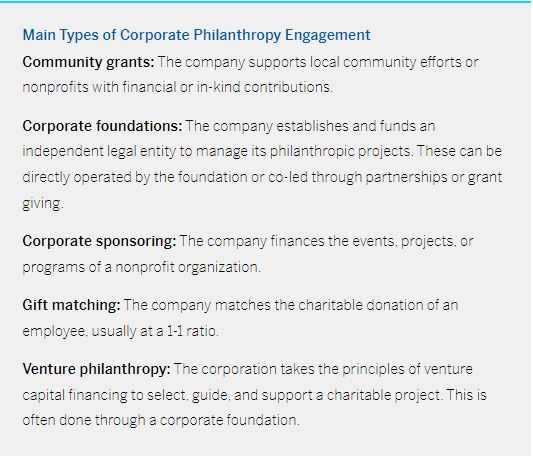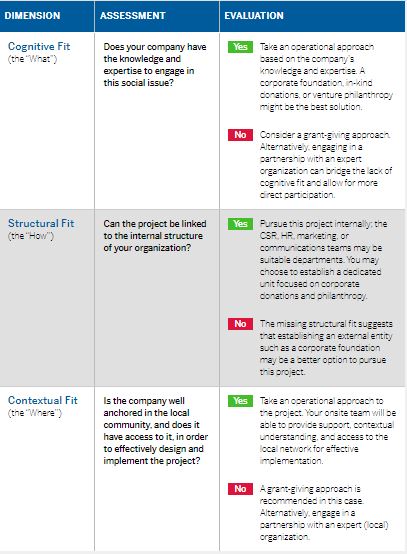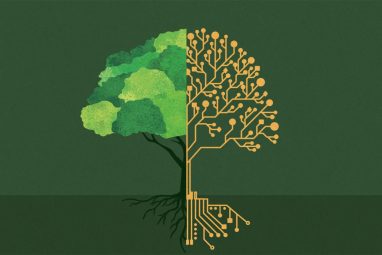Do You Have a Corporate Philanthropy Strategy?
Developing a strategic process for corporate philanthropy decision-making can boost a company’s social impact and competitive edge.
Topics
News
- Private Sector to Outpace Governments in $20 Billion Earth Intelligence Market
- Saudi Arabia to Add 112MW to Data Centre Capacity in New Deal
- UAE Dominates Global Data Centre Rankings as Region Becomes Digital Infrastructure Hotspot
- AI Adoption Climbs 233% Globally with the Middle East Showing Similar Momentum, Report finds
- du Launches UAE’s First Sovereign Hypercloud for Government and AI Innovation
- Ooredoo Launches Sovereign AI Cloud in Qatar Powered by Nvidia GPUs

Corporate philanthropy spending reached new heights in 2021, exceeding $21 billion in the U.S. alone and marking a 24% increase over the previous year.1 These contributions, which traditionally focused on supporting galleries, museums, and shiny new buildings, have gained a higher profile in corporate decision-making. While management scholars have long pointed out the importance of corporate philanthropy, businesses’ approaches to it vary widely, and few have fully integrated it into their corporate strategy.2 This article examines the shifting landscape of corporate giving and the potential implications for businesses and their stakeholders.
As companies face growing pressures to incorporate purposeful social missions into their core businesses, leaders have gained experience managing initiatives aimed at social impact in addition to profit. While corporate social responsibility (CSR) is part of most companies’ business strategies, philanthropy often remains disconnected from core business objectives. This makes it challenging for leaders to discern what types of philanthropic engagement should be prioritized and why.
We define strategic corporate philanthropy as voluntary giving that builds on the company’s core competencies to achieve social impact while improving its competitive edge — resulting in a win-win situation.3 The scope of corporate philanthropic engagement is vast. (See “Main Types of Corporate Philanthropy Engagement.”) Even though gift matching has led the way for many years in the U.S., Coca-Cola, Google, and Walt Disney are just a few of the many multinationals that now engage in more than one type of corporate philanthropy. IBM’s Open Source Community Grant program (with annual contributions of $200,000), the Danone Ecosystem (an impact investment fund with over $200 million committed since 2009), and the Ikea Foundation (with unrestricted funding for selected nonprofits working on emergency relief) are examples of the great diversity of corporate philanthropic engagement.

Increasingly, companies are establishing corporate foundations, which are legally independent entities that work exclusively on philanthropic activities. This allows them to take a more systematic approach to giving and create a “philanthropic identity.” Examples include the Walmart Foundation (with annual giving of $1.5 billion) and the Chanel Foundation (supporting over 150 charitable organizations since 2011). However, guidance remains limited on what type of philanthropic engagement would best fit a company’s strategy.
Corporate philanthropy has the potential to create multiple benefits for a business, including enhanced reputation, legitimacy, local integration, network creation, knowledge acquisition, institutional acceptance, and stakeholder trust. But it also bears risks. Thus, companies must think carefully about what, how, and where to engage.
Our research examines the various strategies companies are testing in the realm of corporate philanthropy.4 When building a corporate philanthropy strategy, a business’s most important decisions revolve around three central issues: what topics to engage in, which parts of the company can support these efforts, and how to maximize impact. First, in terms of engagement, companies can either actively engage in the design, implementation, and evaluation of potential projects (operational), or provide the resources for another organization to take the lead (grant giving). This decision should be based on their knowledge and expertise in their respective field. The second decision is whether to house the project in an external entity, like a corporate foundation, or internally under a department like sustainability, HR, public relations, or partnerships. Lastly, the project must be anchored within the community to make a real impact, either through the company’s own networks in the country or through local partners.
Corporate philanthropy has the potential to create multiple benefits for a business. But it also bears risks.
Our analysis offers a framework to assist managers in their decision-making process, enabling them to ask the right questions to understand the fit of a philanthropic project for their organization. Three dimensions need to be assessed.
Cognitive fit: Does your company have the knowledge and expertise to engage in this social issue? Corporate philanthropy, much like any business activity, demands specialized competencies; thus, companies need to be selective to maximize their impact. Tackling complex issues related to their primary industry is a good starting point because businesses already have expertise in dealing with customers, suppliers, and other stakeholders. Prominent examples include the Loewe Foundation’s commitment to creativity and craftmanship — aligned with its identity as a luxury fashion house — and Adidas’ focus on expanding access to sports for all.
Structural fit: Can the project be linked to the internal structure of your organization? Every project needs organizational support to be integrated with the company’s corporate structure and processes, which will potentially involve CSR, HR, or logistics. But one unit or department has to be in charge of providing adequate economic, human, social, and intellectual capital. We find that different corporations develop very different structural solutions to manage their philanthropic activities. Roche decided to create a whole new department, called the Corporate Donations and Philanthropy department, integrated under the CEO’s office. Inditex still carries out its philanthropic activities within its sustainability department, and Visa chose to manage its donations through the Visa Foundation, as an independent entity.
Contextual fit: Is the company well anchored in the local community, and does it have access to it, in order to effectively design and implement the project? Gaining access to the local context is critical for success — it enhances onsite decision-making capabilities and fosters trust among stakeholders. If the organization engages in a familiar context, it can better tailor social solutions to local needs and do so more efficiently. For instance, HSBC’s Hongkong Bank Foundation has distributed over HK$2.4 billion ($305.8 million) to support the Hong Kong community, its home market. Another example is the eBay Foundation, which encourages its employees to volunteer and give within their local communities.
Answering these questions helps companies craft a corporate philanthropy strategy and determine the implications of alternative pathways. (See “Designing a Corporate Philanthropy Strategy.”) Our assessment framework can be used on individual projects and to systematically manage a portfolio. When planning and defining a potential philanthropic project, managers can answer the questions related to the three dimensions and consider the recommendations given for each option. For example, a U.S.-based fintech company seeking to engage in research projects focused on Alzheimer’s disease would have a low cognitive fit between the philanthropic project and company expertise. It would also have a low structural fit if it did not have an in-house department to support community outreach for medical issues. Additionally, the fintech firm would score low on contextual fit if it were to engage in a program in Somalia — a market in which it doesn’t operate or have specific knowledge. Under these circumstances, a grant-giving strategy through an external body like a foundation would be advisable. As this case reveals, thinking about the three dimensions can help managers establish guiding principles for their corporate philanthropy strategy and set rules regarding what, how, and where to engage.
Designing a Corporate Philanthropy Strategy: An Assessment Framework
Using a structured framework to answer key questions, companies can craft strategies that not only guide the development of potential philanthropic projects but also streamline the management of their philanthropic portfolios.

Our study of the Adecco Group, a Fortune Global 500 company and leader in HR solutions based in Switzerland, offers a prime example of the strategic decision-making process in corporate philanthropy.5 In 2017, the Adecco Group established a global foundation, and leaders took a proactive approach to create synergies between the company’s social and business strategies.
The Adecco Group’s foundation has a clear purpose closely aligned to the corporation’s mission: Making the future work for everyone. Initially, many of its social programs were transferred to the foundation. Over time, however, the Adecco Group’s philanthropic portfolio grew and became very diverse, requiring a detailed assessment across the cognitive, structural, and contextual fit of the programs. In 2021, the management team carefully selected the foundation’s priority projects based on the questions provided in our assessment framework. Accordingly, other initiatives were given back to the company (and integrated into the respective departments), and some were entrusted to better-suited nonprofits to take forward. This strategic move allowed the Adecco Group’s foundation, now called the Innovation Foundation, to redefine its corporate philanthropy strategy and develop a decision-making framework rooted in three principles:
Industry expertise (cognitive fit). The foundation now focuses exclusively on the domains of employment, skills, and the future of work — the business’s areas of expertise. In addition to receiving financial support, it benefits from the knowledge, data, experience, and ecosystem of the Adecco Group. This mutually beneficial relationship ensures that the valuable outcomes and insights generated by the foundation are shared back to the company.
Tailored social innovation lab methodology (structural fit). The foundation developed a proprietary operating model that blends data-driven analysis, design thinking, and innovation to deliver user-centric solutions following an accelerator-like process. Thus, projects that did not align with that format — such as grant giving and fundraising — were given back to the business. These projects were run in the marketing or sustainability department, contingent on their structural fit and their knowledge, personnel, and network needs.
Local knowledge (contextual fit). Because the Innovation Foundation focuses on projects with long-term impact — those that address the source of a problem rather than the symptoms — local partners and end users are involved at every stage. One example is the foundation’s Women Back to Work project in Spain, where the continuous involvement of local organizations and beneficiaries ensures that the program incorporates a deep understanding of the real problems of women reintegrating into the workforce in that context. Once a project has been developed and tested in-house, it is spun off for a local partner organization to scale and create maximum impact.
In the year following the foundation’s restructuring, the team pursued three projects aimed at boosting employability for women, young adults, and older employees. These initiatives have provided the company with insights and real-time data on the unmet needs and potential solutions for underserved populations in the labor market.
The Adecco Group’s case demonstrates the power of a well-crafted corporate philanthropy strategy that is grounded in guiding principles. As corporate giving becomes increasingly important in today’s business landscape, it’s critical for companies to focus their efforts on maximizing their social impact as well as their competitive position. A well-executed philanthropic strategy not only benefits society but also strengthens an organization’s market position by providing access to new knowledge and expanding the organization’s network.





